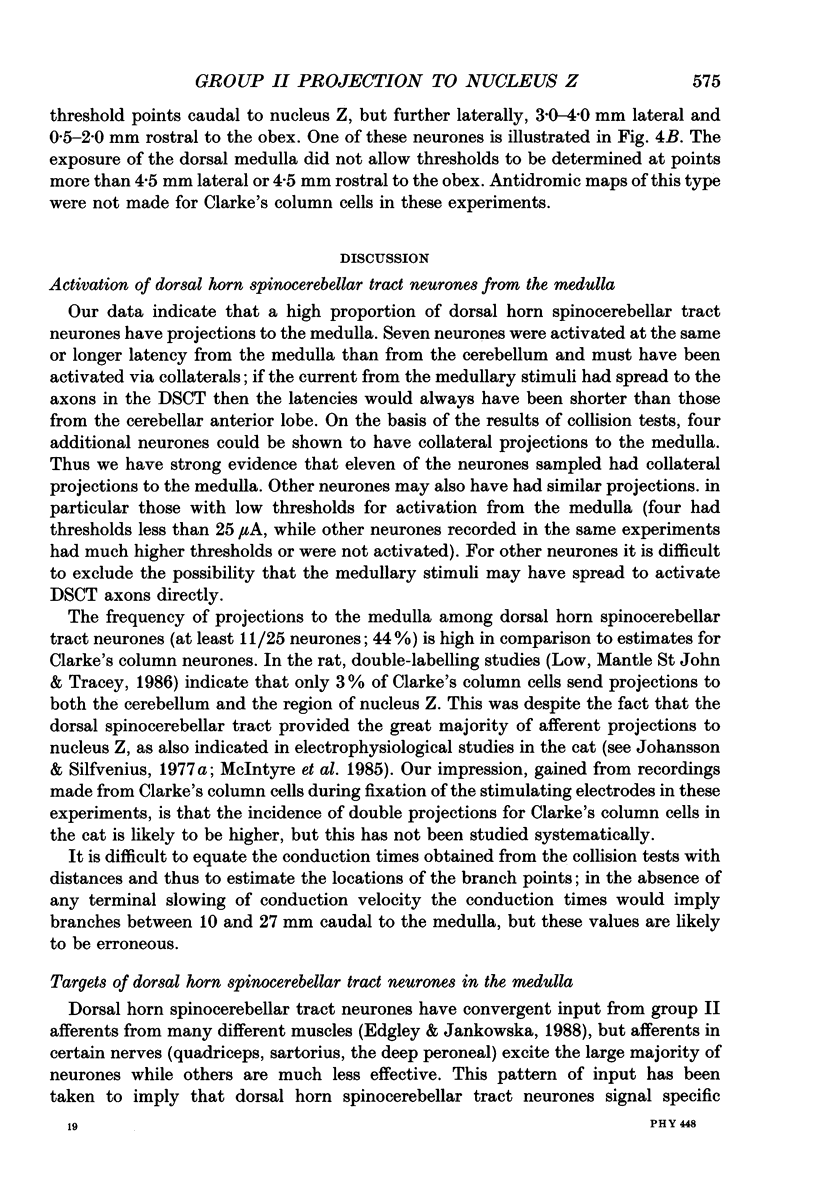Abstract
1. The possibility that dorsal horn spinocerebellar tract neurones in the midlumbar segments of the cat spinal cord which convey information from hindlimb group II muscle afferents to the cerebellum send collateral projections to medulla in the region of nucleus Z has been examined. 2. Dorsal horn spinocerebellar tract neurones (n = 25) were identified by antidromic activation from the cerebellum and by synaptic activation following stimulation of hindlimb group II afferents. A high proportion (21/25) were also antidromically activated by stimuli delivered to the region of nucleus Z. 3. The results of collision tests between antidromic spikes evoked from the cerebellum and the medulla and the fact that the latency for antidromic activation from nucleus Z at threshold was greater than from the cerebellum indicates that at least 11/25 (44%) of the neurones had collateral projections to the medulla. 4. Antidromic threshold mapping revealed that some of the neurones could be activated from parts of the dorsal medulla adjacent to, but not directly overlying, nucleus Z. The possible relevance of these data with regard to sensation of lower limb position and motion is discussed.
Full text
PDF













Selected References
These references are in PubMed. This may not be the complete list of references from this article.
- Burgess P. R., Wei J. Y., Clark F. J., Simon J. Signaling of kinesthetic information by peripheral sensory receptors. Annu Rev Neurosci. 1982;5:171–187. doi: 10.1146/annurev.ne.05.030182.001131. [DOI] [PubMed] [Google Scholar]
- ECCLES J. C., OSCARSSON O., WILLIS W. D. Synaptic action of group I and II afferent fibres of muscle on the cells of the dorsal spinocerebellar tract. J Physiol. 1961 Oct;158:517–543. doi: 10.1113/jphysiol.1961.sp006783. [DOI] [PMC free article] [PubMed] [Google Scholar]
- Edgley S. A., Gallimore C. M. The morphology and projections of dorsal horn spinocerebellar tract neurones in the cat. J Physiol. 1988 Mar;397:99–111. doi: 10.1113/jphysiol.1988.sp016990. [DOI] [PMC free article] [PubMed] [Google Scholar]
- Edgley S. A., Jankowska E. Information processed by dorsal horn spinocerebellar tract neurones in the cat. J Physiol. 1988 Mar;397:81–97. doi: 10.1113/jphysiol.1988.sp016989. [DOI] [PMC free article] [PubMed] [Google Scholar]
- Fern R., Harrison P. J., Riddell J. S. The dorsal column projection of muscle afferent fibres from the cat hindlimb. J Physiol. 1988 Jul;401:97–113. doi: 10.1113/jphysiol.1988.sp017153. [DOI] [PMC free article] [PubMed] [Google Scholar]
- Grant G., Xu Q. Routes of entry into the cerebellum of spinocerebellar axons from the lower part of the spinal cord. An experimental anatomical study in the cat. Exp Brain Res. 1988;72(3):543–561. doi: 10.1007/BF00250600. [DOI] [PubMed] [Google Scholar]
- Harrison P. J., Jami L., Jankowska E. Further evidence for synaptic actions of muscle spindle secondaries in the middle lumbar segments of the cat spinal cord. J Physiol. 1988 Aug;402:671–686. doi: 10.1113/jphysiol.1988.sp017228. [DOI] [PMC free article] [PubMed] [Google Scholar]
- Johansson H., Silfvenius H. Axon-collateral activation by dorsal spinocerebellar tract fibres of group I relay cells of nucleus Z in the cat medulla oblongata. J Physiol. 1977 Feb;265(2):341–369. doi: 10.1113/jphysiol.1977.sp011720. [DOI] [PMC free article] [PubMed] [Google Scholar]
- Johansson H., Silfvenius H. Connexions from large, ipsilateral hind limb muscle and skin afferents to the rostral main cuneate nucleus and to the nucleus X region in the cat. J Physiol. 1977 Feb;265(2):395–428. doi: 10.1113/jphysiol.1977.sp011722. [DOI] [PMC free article] [PubMed] [Google Scholar]
- Johansson H., Silfvenius H. Input from ipsilateral proprio- and exteroceptive hind limb afferents to nucleus Z of the cat medulla oblongata. J Physiol. 1977 Feb;265(2):371–393. doi: 10.1113/jphysiol.1977.sp011721. [DOI] [PMC free article] [PubMed] [Google Scholar]
- LLOYD D. P. C., McINTYRE A. K. Dorsal column conduction of group I muscle afferent impulses and their relay through Clarke's column. J Neurophysiol. 1950 Jan;13(1):39–54. doi: 10.1152/jn.1950.13.1.39. [DOI] [PubMed] [Google Scholar]
- Landgren S., Silfvenius H. Nucleus Z, the medullary relay in the projection path to the cerebral cortex of group I muscle afferents from the cat's hind limb. J Physiol. 1971 Nov;218(3):551–571. doi: 10.1113/jphysiol.1971.sp009633. [DOI] [PMC free article] [PubMed] [Google Scholar]
- Low J. S., Mantle-St John L. A., Tracey D. J. Nucleus z in the rat: spinal afferents from collaterals of dorsal spinocerebellar tract neurons. J Comp Neurol. 1986 Jan 22;243(4):510–526. doi: 10.1002/cne.902430406. [DOI] [PubMed] [Google Scholar]
- Matthews P. B. Where does Sherrington's "muscular sense" originate? Muscles, joints, corollary discharges? Annu Rev Neurosci. 1982;5:189–218. doi: 10.1146/annurev.ne.05.030182.001201. [DOI] [PubMed] [Google Scholar]
- McIntyre A. K., Proske U., Rawson J. A. Pathway to the cerebral cortex for impulses from tendon organs in the cat's hind limb. J Physiol. 1985 Dec;369:115–126. doi: 10.1113/jphysiol.1985.sp015891. [DOI] [PMC free article] [PubMed] [Google Scholar]
- Shinoda Y., Arnold A. P., Asanuma H. Spinal branching of corticospinal axons in the cat. Exp Brain Res. 1976 Oct 28;26(3):215–234. doi: 10.1007/BF00234928. [DOI] [PubMed] [Google Scholar]
- Swadlow H. A. Antidromic activation: measuring the refractory period at the site of axonal stimulation. Exp Neurol. 1982 Feb;75(2):514–519. doi: 10.1016/0014-4886(82)90179-0. [DOI] [PubMed] [Google Scholar]
- Wei J. Y., Simon J., Randić M., Burgess P. R. Ascending spinal axons that signal the position of the hindlimbs under static conditions: location and receptor input. Exp Brain Res. 1984;54(1):7–22. doi: 10.1007/BF00235814. [DOI] [PubMed] [Google Scholar]


